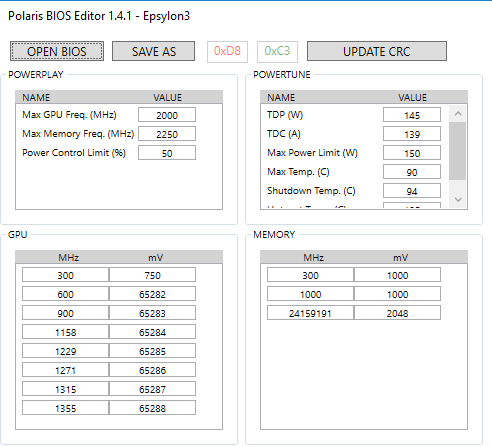The AMD Radeon RX 580 & RX 570 Review: A Second Path to Polaris
by Ryan Smith on April 18, 2017 9:00 AM EST- Posted in
- GPUs
- AMD
- Radeon
- Polaris
- Radeon RX 500
The Test
Before diving into our tests, I want to quickly touch upon the test setup. Since AMD isn’t making any reference RX 580 or RX 570 cards, they instead sent over the PoworColor and Sapphire cards listed on the previous page. However both of those are factory overclocked, so both needed to be underclocked to stand-in for the baseline RX 580 and RX 570 cards.
The trick with underclocking cards like this isn’t the clockspeeds, but rather the power consumption. Factory overclocked cards are frequently built and configured for higher TDPs to support their frequencies, which can throw off our results, especially if a baseline card would power throttle in the same situation. So it’s sometimes not enough to simply underclock a card to represent the baseline performance.
In the case of today’s cards, thankfully both of them ship with a second, lower power BIOS. PowerColor calls this Quiet OC on the Red Devil RX 580, and along with reducing the max GPU power by 20W, it reduces the GPU boost clock to 1355MHz, a 15MHz overclock. Sapphire does one better on their Nitro+, as the second BIOS reduces the GPU power by 25W and brings the card down to AMD’s reference clocks.

PowerColor RedDevil RX 580's "Quiet OC" BIOS
Unfortunately the power limit coded into the BIOS don’t perfectly correlate with TBP – the value is just for GPU power – so it’s difficult to precisely tell if these BIOSes match AMD’s 185W and 150W TBPs. However if these values are off, they should still be close to what a real baseline card would get, as they’re in the ballpark of what I’d expect for AMD’s TBPs to begin with. So our results here should be reasonably accurate here for both total power consumption and for accounting for any power throttling during testing.
For our review of the Radeon RX 580 & RX 570, we’re using AMD’s “Crimson Press” driver, version 17.10.1030. Going by the build number, this driver appears to be between the latest 17.3.1 and 17.4.1 Crimson public drivers.
| CPU: | Intel Core i7-4960X @ 4.2GHz |
| Motherboard: | ASRock Fatal1ty X79 Professional |
| Power Supply: | Corsair AX1200i |
| Hard Disk: | Samsung SSD 840 EVO (750GB) |
| Memory: | G.Skill RipjawZ DDR3-1866 4 x 8GB (9-10-9-26) |
| Case: | NZXT Phantom 630 Windowed Edition |
| Monitor: | Asus PQ321 |
| Video Cards: | PowerColor Red Devil Radeon RX 580 Sapphire Nitro+ Radeon RX 570 AMD Radeon RX 480 (8GB) AMD Radeon RX 470 AMD Radeon R9 380 AMD Radeon R7 370 NVIDIA GeForce GTX 1070 Founder's Edition NVIDIA GeForce GTX 1060 Founder's Edition NVIDIA GeForce GTX 1050 Ti NVIDIA GeForce GTX 960 NVIDIA GeForce GTX 950 |
| Video Drivers: | NVIDIA Release 381.65 AMD Radeon Software Crimson Press Beta 17.10.1030 |
| OS: | Windows 10 Pro |










129 Comments
View All Comments
BrokenCrayons - Tuesday, April 18, 2017 - link
The acoustics are superb! Buuuuut, the problem is that we're already looking at vendor boards so that might not be the case for every 580 and 570 out there since there'll probably be a variety of different cooling solutions in the wild.nathanddrews - Tuesday, April 18, 2017 - link
Most definitely, but for an aggressively OC air-cooled model to be quieter at load than a 950 and be over 10dBA quieter than the reference 470/480, AIB partners would have to really do something wrong to make a loud card. I'm sure it will happen, but it would have to be like a 40mm, single-slot design or something... hahaMr Perfect - Tuesday, April 18, 2017 - link
What I'd like to know is why did a 6% increase in clocks cost a 23% power increase? That seems unusually high, unless Polaris was up against the wall already in the 400 series.rarson - Tuesday, April 18, 2017 - link
I think you answered your own question..."Polaris was up against the wall already in the 400 series."
Samus - Tuesday, April 18, 2017 - link
I think the most revolutionary inclusion in this Polaris revision is the memory state (especially since little else is changed)And I use the word revolutionary because this is an eye opening reception for AMD and Intel (and nVidia) on the computing front. Imagine variable clock speeds for memory, and even overboost/turbo mode for memory for momentary spikes in demand. The voltage savings combined with the marginally added boost performance wouldn't be something to right off in the grand scheme of things. I suspect we will see this technique adopted across the board soon.
JoyTech - Tuesday, April 18, 2017 - link
Is there any data for release of Vega GPUs?Ryan Smith - Tuesday, April 18, 2017 - link
AMD's last comment was Q2 of this year.vladx - Wednesday, April 19, 2017 - link
So 99% it will be released in June.hoohoo - Tuesday, April 18, 2017 - link
Still should have called them 475 and 485. This is underwhelming. It seems like the performance bump is all from clocks. The process is perhaps able to handle higher voltages, thus slight clock bump. 2.5 slot coolers are not good.DanNeely - Tuesday, April 18, 2017 - link
These cards are to keep the OEMs happy. Even if it's the exact same product under the hood, they need a new model year to feed their marketing/sales channels. The people in them aren't gamers and PC enthusiasts who roll their eyes at this sort of thing; they're rebooting their tablets by flipping them upside down and shaking them.http://dilbert.com/strip/1995-04-03
The Vega cards we're all looking forward to will presumably be launching under 590 and Fury brandings later.